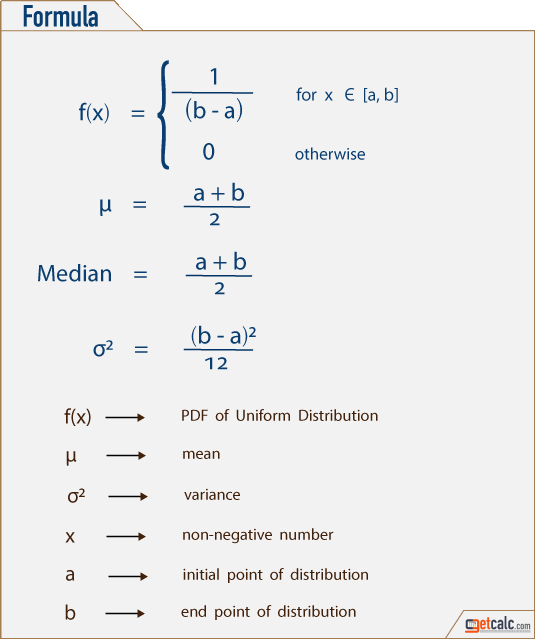Uniform Distribution Calculator
Uniform distribution probability (PDF) calculator, formulas & example work with steps to estimate the probability of maximim data distribution between the points a & b in statistical experiments. By using this calculator, users may find the probability P(x), expected mean (μ), median and variance (σ2) of uniform distribution. This uniform probability density function calculator is featured to generate the work with steps for any corresponding input values to help beginners to learn how the input values are being used in such calculations.
NotesThe below are the important notes to remember to supply the corresponding input values for this probability density function of uniform distribution calculator.
- The random variable x is the non-negative number value which must be greater than or equal to 0. The uniform distribution is evaluated at this random value x.
- The lower limit a is the positive or negative number which represents the initial point of curve.
- The upper limit b is the positive or negative number which represents the end point of curve.
- For inverse uniform distribution, P(x) is probability density function form which must be between 0 and 1 which generally represented by 0 ≤ x ≤ 1.
Uniform Distribution & Formula
Uniform distribution is an important & most used probability & statistics function to analyze the behaviour of maximum likelihood of data between two points a and b. It's also known as Rectangular or Flat distribution since it has (b - a) base with constant height 1/(b - a). It's one of a continous probability functions popularly used in statistics & probability to characterize the data distribution. The term P(x) represents the probability of maximum likelihood, mean (μ) represents the expected likelihood of data & σ2 represents the variation among the group of data. Whereas the inverse function estimates the negative probability of Uniform distribution between two points.
FormulaThe below formula is mathematical representation of Uniform probability density function may help users to know what are all the input parameters are being used in such calculations to characterize the data distribution. Users may use these below uniform distribution formulas for manual calculations and use this calculator to verify the results of manual calculations or generate complete work with steps.

Solved Example Problems with Steps
The below are some of the solved examples with solutions for Uniform probability density function to help users to know how to estimate the probabilty of maximum data distribution between two points.
- A random variable x has the uniform distribution with the lower limit a = 2 and upper limit b =9. Evaluate the probability of random variable x = 4 which lies between the limits of distribution.
- A random variable x = 7 has the uniform distribution with the lower limit a = 5 and upper limit b =15. Find the mean, median and variance of the distribution along with the probability of random variable which lies between the limits?
- An uniform distribution has the probability of random variable P(x) = 0.25 between the lower limit a = 3.5 and upper limit b = 7.2. What is the inverse probability density function of this distribution to estimate the random variable?

